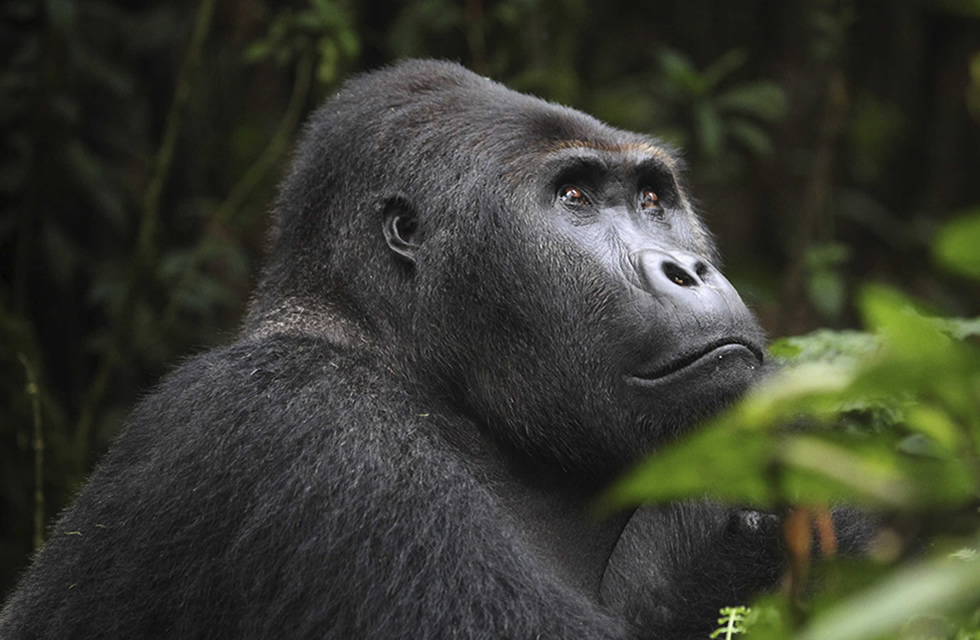Well aside from the fact that one group is found in the lowlands, and the other in the mountains, these gorillas differ is physical appearance as well. While lowland gorillas are smaller with brownish-Grey coats, mountain gorillas are huge and have black coats. In terms of population, there are lowland gorillas than mountain gorillas. The numbers are over 100,000, and about 800 respectively.
Western lowland gorillas can be distinguished from other gorilla subspecies by their slightly smaller size, their brown-grey coats and auburn chests. They also have wider skulls with more pronounced brow ridges and smaller ears. Large numbers have not protected the western lowland gorilla from decline.
Mountain Gorillas are found in Bwindi and Mgahinga in Uganda, the Parc Nationale des Volcans of Rwanda and the Virunga National Park in Democratic Republic of Congo. The western lowland gorilla is the most numerous and widespread of all gorilla subspecies. Populations can be found in Cameroon, the Central African Republic, the Democratic Republic of Congo and Equatorial Guinea as well as in large areas in Gabon and the Republic of Congo.
Where do you go to see lowland gorillas?
The best place to see lowland gorillas is the Odzala- Kokoua National Park in the north of the Democratic Republic of Congo near the Congo-Gabon border. The coat of a gorilla permit in Congo is included as part of the total cost of the trip.
What should you put in consideration if you want to see mountain gorillas?
Rwanda and Uganda are the best places for mountain gorilla trekking and this is what you should consider when choosing whether to go on a gorilla trekking safari in Africa;
Gorilla tracking permits:
Each Rwanda Gorilla permit cost US$ 750 per person, while in Uganda, gorilla permits go for US$ 600 per permit. It is advisable to book your permit in advance to be secure of tracking Gorillas. The permit gets you a full hour of time spent with family mountain gorillas.
Access: In Rwanda you have it is easier to access gorilla trekking opportunities. The drive from Kigali airport to Volcanoes National Park is short, so you can easily combine a gorilla trekking trip with a visit to neighboring Tanzania, Burundi, Uganda and the further away Kenya. In Uganda on the other hand, while you can combine the trip with safaris to the neighboring countries as well, the drive from the Entebbe International Airport to either Bwindi Impenetrable Forest or Mgahinga national park is very long – approximately 7-8 hours drive.
We therefore recommend that if you intend to trek in Uganda then you should perhaps book an 3 day safari, if you cannot and can only enjoy this adventure for a couple ideas, then Rwanda is your place to be.
How difficult is the trek?
Tracking gorillas in either country is quite tiring, and can be challenging thus some level of witness needed. You might have to hike for hours before you find them, though Rwanda gorilla trekking is much easier than these of Uganda and Democratic Republic of Congo.
Therefore, weak visitors, aged and other disabilities but wanting to see gorillas are advised to trek Rwanda Gorillas. In Volcanoes National Park, the shortest trek can take 1-3 hours and some times few minutes walk from the park headquarters.
The altitude also contributes greatly to the strain of the hike because the trekking happens at an altitude range of 8000-10,000ft. It is not high enough for altitude sickness, but it is high enough to be tiring and get you out of breath quite fast. Rwanda generally lies at an average altitude of 5000ft, and western Uganda is equally hilly and mountainous so spending a few days in the area, or in similar areas such as the Nairobi or Masai Mara, could be good preparation for your gorilla tracking adventure.
Are the gorillas in Uganda different from those in Rwanda?
No, the gorillas in either country are pretty much the same so is the gorilla trekking system. The only difference is in the number of gorilla families. Rwanda has 10 habituated gorilla families, while Uganda has 11 habituated gorilla families and more yet to be officially launched. The gorillas move freely in between Rwanda, Uganda and Democratic Republic of Congo.

Leave a Reply